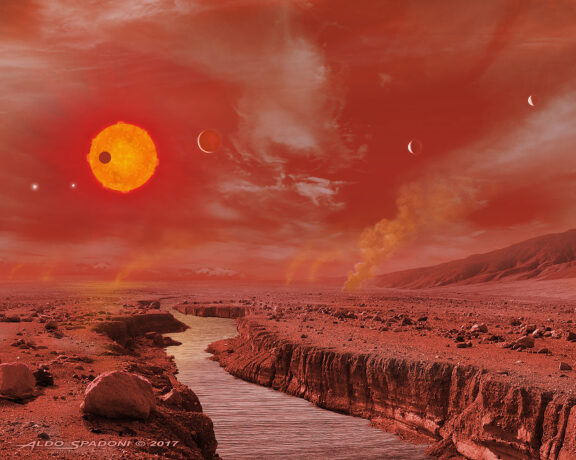Are exoplanet 'terminator zones' a lead in the search for life?

Written by
Ariel Barreiro
Communications Intern, The Planetary Society
August 10, 2023
In the search for extraterrestrial life, the study of so-called “terminator zones” on exoplanets is becoming more advanced. So far, the search for life as we know it has been largely associated with identifying Earth-like worlds. Exoplanets with terminator zones, on the other hand, are worlds with drastically different temperatures on either side of the planet. These unusual worlds of extremes may challenge our traditional understanding of habitability.
What are terminator zones?
Some exoplanets are tidally locked with their parent star, meaning they rotate at just the right speed to always have the same side pointing at the star as they orbit. Tidal locking (also called synchronous rotation) can create a stationary band on the planet’s surface that’s referred to as the terminator zone: a line separating the scorching — sometimes even volcanic — dayside from the glacial nightside of the exoplanet. Studies of terminator zones have, so far, primarily focused on planets tidally locked with M-dwarf stars, which are significantly dimmer than our own Sun.

Terminator zones are different from “terminators” in our own Solar System. On Earth, for example, the terminator is the line between day and night. Unlike terminator zones that stay in fixed locations on tidally locked exoplanets, Earth’s terminator passes over a given point on the surface twice a day due to our planet’s rotation as it orbits the Sun.
Ana Lobo, a postdoc at the University of California, Irvine studying planetary atmospheres, led the team responsible for the initial modeling of the terminator zone on a hypothetical exoplanet. Her team’s paper was published in The Astrophysical Journal.
“When imagining a synchronously rotating planet, it is somewhat intuitive to expect milder temperatures at the terminator,” Lobo said. “However, earlier studies of synchronously rotating planets found different climate regimes and it was unclear if terminator habitability was possible. Our group set out to understand what the conditions are for terminator habitability to occur and to better understand this climate regime.”
It seems a specific set of circumstances may be necessary for an exoplanet to have a terminator zone. Along with the varying temperatures caused by tidal locking, for an exoplanet to have terminator habitability it must have a limited amount of water.
“Planets with a limited amount of water, especially if they have a rocky surface instead of a global ocean, will tend to have more diverse surface climates,” said Lobo.
At an exoplanet’s terminator zone, temperatures are likely to be more moderate than on either the night side or day side. These conditions could be suitable for the existence of liquid water, and even life. Terminator zone exoplanets are not completely habitable worlds, but rather worlds with one specific, hypothetically habitable region.

Terminator zones and the search for life
For a terminator zone to be potentially habitable, it needs to be in orbit around the right size of star. Planets only develop tidal locking when they orbit close to their host star. Mercury is the closest thing to a tidally locked planet that we see in our Solar System, but it is too far to have become fully locked; it takes 88 days to orbit the Sun, and 57 days to rotate (a 3:2 spin-orbit resonance). But as we see from Mercury, even its proximity to a star like our Sun creates temperatures that are far too extreme for habitability.
Around cooler, smaller red dwarf (or M-dwarf) stars, the region where planets can become tidally locked aligns with the star’s habitable zone, where temperatures allow for liquid water on a planet’s surface. About 75% of all stars are M-dwarf stars. In comparison, our Sun, a G-type main sequence star that makes up only about 7% of stars in the Universe.
“We suspect many of the planets orbiting M-stars are tidally locked because they are close to their stars, while still being in the habitable zone, which is an interesting scenario,” said Stephen Kane, a professor of planetary astrophysics at the University of California, Riverside who was not affiliated with the Lobo study.
Because life as we know it requires liquid water, the search for life on exoplanets has typically focused on water-abundant worlds. A narrow window of 0-100 degrees Celsius and a consistent and sufficient atmospheric pressure are needed for liquid water to pool. While these conditions are rare to find on entire exoplanets, they might be more common along terminator zones of tidally locked exoplanets, as long as they meet certain other criteria.
One other condition necessary for habitability may be volcanism. Kane believes that volcanism is a “necessary but insufficient requirement for habitability” So, while he expects to see volcanism on an exoplanet with a terminator zone, volcanism is not the only indication that the exoplanet will have one.
“Volcanism could play an interesting and important role in the climate of these planets,” Lobo added.
A highly active volcanic planet, however, may produce too much carbon dioxide and effectively destroy its chances at habitability along the terminator zone. According to Kane, excessive amounts of carbon dioxide could create a runaway greenhouse effect, where thermal radiation is trapped. This would hypothetically prevent liquid water from forming — not ideal conditions for habitability, whether along a terminator zone or across an entire planet.

Proximity might be a hindrance when creating a habitable terminator zone as well. New information from NASA’s James Webb Space Telescope (JWST) shows that the TRAPPIST-1 exoplanet system has a few tidally locked planets. However, at least two of them appear to have lost their atmosphere, disqualifying them as potential targets in the search for life. An atmosphere is necessary for the kind of habitability scientists are searching for.“If this trend continues, then it could mean that terminator habitability is exceptionally rare because you need everything to line up,” Kane said.“You need the planet to be in the habitable zone. You need it to be close to its star, preferably an M-dwarf. But you need it to have also retained its atmosphere, which is turning out to be no small task for planets that exist around M-dwarfs.”
The future of terminator zone research
Studying terminator zones may help scientists expand their pool of options and consider some alternatives in the search for life.
“Understanding planetary climate regimes, with studies such as this one, is important for helping prepare for the next generation of telescopes so that we can get the best possible results,” Lobo said. She encouraged more work to be done on simulations of exoplanets with more land than water.
Concept missions like the Habitable Worlds Observatory may allow for more detailed understanding of terminator zone exoplanets. This telescope would measure six meters across and operate in the ultraviolet, visible and near infrared light spectrums. Its primary focus would be to image Earth-like worlds and search for biosignature gasses, our main indicators that there may be life present on an exoplanet.
“The next generation of telescopes will be very exciting in terms of what we might discover on smaller exoplanets,” Lobo said. “But I also think JWST still has many surprises in store for us. If there is one thing I’ve learned about exoplanet studies in the past few years, it’s that the science often progresses faster than we expect.”
With the advancement of so many telescopes and technologies, terminator zones have the potential to be an interesting and surprising area of study in the hunt for habitability.
Support our core enterprises
Your gift today will go far to help us close out the year strong and keep up our momentum in 2026.
Donate

 Explore Worlds
Explore Worlds Find Life
Find Life Defend Earth
Defend Earth

